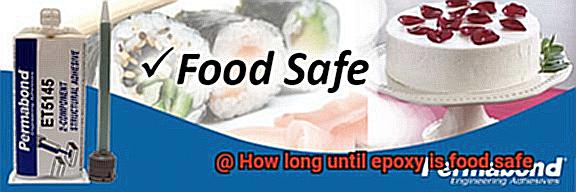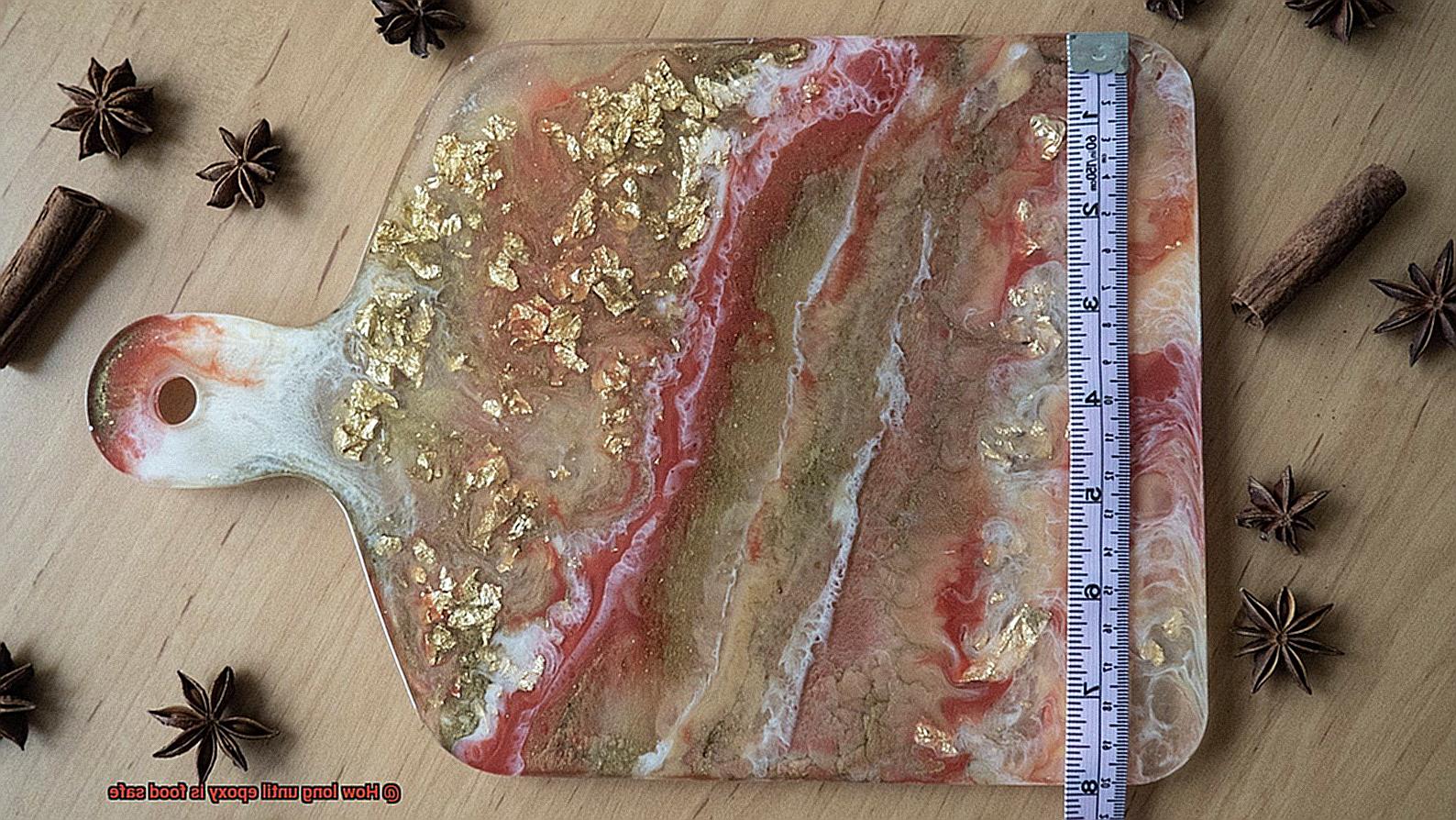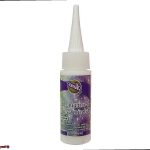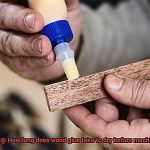Are you itching to use epoxy in your kitchen or dining area?
Contents
- 1 What is Epoxy?
- 2 Safety of Epoxy in Food Contact Applications
- 3 Components of Epoxy and Curing Process
- 4 Formation of Cross-Linked Polymer Network
- 5 Is Epoxy Immediately Food Safe?
- 6 Recommended Curing Time for Food Safety
- 7 Cleaning the Cured Epoxy Surface
- 8 Durability and Chemical Resistance of Properly Cured Epoxy
- 9 Conclusion
Maybe you’re a DIY fanatic, eager to craft your very own one-of-a-kind food serving platters or countertops. But hold up.
There’s an important question that begs to be answered: just how long until epoxy becomes safe for food contact? It’s a timeline worth knowing, for the sake of your well-being and that of your beloved ones.
So, let’s dive right in and uncover the truth.
What is Epoxy?

Epoxy, the adhesive of choice for professionals and DIY enthusiasts, is a versatile polymer known for its incredible strength, durability, and resistance to environmental factors. By understanding its uses, properties, and considerations for food safety, we can truly appreciate the power of epoxy.
At its core, epoxy is a two-component adhesive consisting of a resin and a hardener. When these components are mixed in specific ratios, they undergo a chemical reaction called curing. This transformation turns the liquid or semi-liquid resin into a solid material with exceptional adhesive properties. The resulting cured epoxy forms strong bonds with metals, plastics, ceramics, wood, and more.
What sets epoxy apart is its ability to withstand extreme conditions. It can handle high temperatures, moisture, chemicals, and the test of time. This makes it invaluable in industries like construction, automotive, and electronics where durability is paramount. Its excellent electrical insulation properties make it a popular choice for electrical components as well.
Epoxy’s versatility shines through its ability to be modified through additives. These additives can enhance specific properties such as flexibility, impact resistance, or UV resistance. This adaptability allows epoxy to meet the unique requirements of different applications.
Beyond its adhesive properties, epoxy also excels as a coating and sealant. Applied as a thin layer on surfaces, it forms a protective barrier against corrosion, moisture intrusion, and wear and tear. Epoxy coatings are commonly used on floors, walls, and other surfaces that demand long-lasting protection.
Now let’s address the question of food safety. While epoxy can be safe for use in areas that come into contact with food, it depends on various factors including formulation and curing process.
During curing, epoxy undergoes chemical reactions that result in the formation of a cross-linked polymer network. This network defines the adhesive properties and physical characteristics of the cured epoxy. Although epoxy may harden within hours, it does not guarantee immediate food safety. The curing process continues over time as the epoxy reaches its full strength and stability.
To ensure epoxy is food safe, it is crucial to follow manufacturer instructions regarding curing times and safety guidelines. Typically, epoxy requires 24 to 72 hours of curing before it can be considered safe for food contact. After the recommended curing time has passed, thoroughly clean the cured epoxy surface with mild soap and water before using it for food preparation or contact.
Remember, properly cured epoxy forms a durable and chemically resistant surface that is non-toxic and safe for direct food contact. However, regular inspection and maintenance are necessary as epoxy coatings or adhesives may deteriorate over time due to environmental factors or wear and tear.
Safety of Epoxy in Food Contact Applications
When it comes to the safety of our food, we want to be absolutely sure that every material and product that comes into contact with it is completely safe for consumption. This includes the adhesives used in food packaging and food contact applications. One adhesive that is commonly used in these applications is epoxy. But what about the safety of epoxy in food contact applications? Let’s dive deep into the world of epoxy and explore its safety in this crucial area.
First and foremost, it’s important to note that not all epoxy adhesives are created equal. When it comes to using epoxy in food contact applications, it is crucial to choose an adhesive that is specifically formulated for this purpose. These epoxy adhesives are often labeled as “food safe” or “FDA compliant.” But what does that really mean? It means that these adhesives have undergone rigorous testing to ensure that they meet the strict safety standards set by the Food and Drug Administration (FDA) and other regulatory bodies.
The FDA has established regulations and guidelines for materials that come into contact with food, and this includes epoxy adhesives. These regulations include migration limits, which determine the amount of potentially harmful substances that can migrate from the adhesive into the food. Epoxy adhesives used in food contact applications must comply with these migration limits.
To ensure compliance, manufacturers of epoxy adhesives for food contact applications conduct extensive testing. They take migration testing and toxicological evaluations very seriously. These tests assess the potential risk of migration of substances from the epoxy adhesive into the food, as well as evaluate their potential toxicity. Manufacturers may also obtain certifications or approvals from third-party organizations to further validate the safety of their epoxy adhesives.
So, if you’re using epoxy adhesives labeled as “food safe” or “FDA compliant,” you can rest assured that they are considered safe for use in food contact applications. However, it’s still crucial to follow proper handling and application procedures. This includes allowing sufficient curing time before the epoxy adhesive comes into contact with food. Curing time varies depending on the specific epoxy adhesive and its intended use, so refer to the manufacturer’s guidelines for the recommended curing time.
In conclusion, epoxy adhesives can indeed be safe for use in food contact applications when they are specifically formulated, tested, and labeled as “food safe” or “FDA compliant.” Manufacturers go through extensive measures to ensure that these adhesives meet the necessary safety requirements. Just remember to handle and apply them correctly, allowing sufficient curing time, to ensure optimal safety in food contact applications.
Components of Epoxy and Curing Process
Epoxy is a remarkable adhesive that bonds materials together with strength and durability. Whether you’re fixing a broken ceramic mug or creating a food-safe container, understanding the components of epoxy and its curing process is essential. Let’s dive into the fascinating world of epoxy and explore how it becomes food safe.
Components of Epoxy:
Epoxy consists of two main components: resin and hardener. The resin is a thick liquid containing reactive chemicals that provide bonding strength. The hardener, a separate liquid or powder, initiates the curing process by reacting with the resin. When these components combine, magic happens.
Curing Process:
The moment resin and hardener meet, polymerization occurs—a chemical reaction transforming liquid epoxy into a solid state, creating a robust bond. But how long does epoxy take to cure? Well, that depends on several factors.
Temperature:
Temperature plays a crucial role in epoxy’s curing process. Higher temperatures accelerate curing time, while lower temperatures slow it down. Following the manufacturer’s temperature requirements ensures optimal results.
Humidity:
Believe it or not, humidity affects epoxy curing too. High humidity levels can slow down the process due to increased moisture in the air. Conversely, low humidity speeds up curing as it aids in water molecule evaporation from the epoxy mixture.
Type of Epoxy:
Not all epoxies are created equal. Different types have distinct properties and recommended curing times. For food contact safety, always choose epoxy specifically designed for this purpose and follow recommended curing times provided by the manufacturer.
Resin-to-Hardener Ratio:
The ratio of resin to hardener used is vital. Deviating from the recommended ratio can prolong or shorten curing time and result in incomplete curing. Stick to the manufacturer’s instructions for optimal results.
Curing Stages:
Once mixed and applied, epoxy undergoes various stages during the curing process. It starts as a liquid, gradually thickens, and enters the gel stage where it becomes less flowable and begins to solidify. This stage’s duration depends on environmental conditions and epoxy type.
The cure stage follows, where epoxy hardens and achieves final strength. Full curing time varies but generally takes 24 hours or longer for epoxy to reach maximum strength and become fully food safe.
Formation of Cross-Linked Polymer Network
Whether you’re fixing a broken mug or creating a food-safe container, understanding the process of epoxy formation is key. So, grab your favorite epoxy-fixed mug and let’s dive into the fascinating world of cross-linked polymer networks.
The Components:
Epoxy consists of two main components: epoxy resin and a curing agent (hardener). These components are mixed in a specific ratio, usually one part resin to one part hardener. Ensuring the correct ratio is crucial for optimal results.
Cross-Linking Magic:
During the curing process, epoxy undergoes cross-linking, a chemical reaction where resin molecules react with hardener molecules, forming covalent bonds. These bonds link the polymer chains together, creating a three-dimensional network that gives epoxy its strength and durability.
Time is of the Essence:
The time required for epoxy to become fully cured and food safe depends on factors such as epoxy type and curing conditions. Quick-curing epoxies can become food safe within hours, while others may require longer curing times for optimal performance.
Temperature and Humidity Matters:
Curing conditions, like temperature and humidity, play a crucial role in epoxy’s curing process. Higher temperatures accelerate curing, while lower temperatures slow it down. Following manufacturer instructions for recommended curing conditions ensures proper curing and food-safe results.
The Final Product:
Once fully cured, epoxy forms a strong and inert material resistant to chemicals and moisture. This makes it suitable for various applications, including those involving food contact. However, not all epoxies are food safe. Choosing an epoxy labeled specifically as food safe ensures utmost safety in food-related applications.
Is Epoxy Immediately Food Safe?
You may be tempted to believe that once epoxy has dried and hardened, it is immediately safe for food contact. After all, it looks solid and feels dry to the touch. However, the reality is a bit more complex.
Epoxy consists of two components: resin and hardener. When these components are mixed together, they undergo a chemical reaction known as curing, which transforms the epoxy from a liquid state into a solid material. This curing process takes time, typically several hours or even days, depending on the type of epoxy being used.
During the curing process, the epoxy molecules cross-link, creating a strong bond and ensuring its stability and durability. However, until the curing process is complete, there may still be residual chemicals present in the epoxy that could potentially leach into food or come into contact with it.
Factors such as temperature, humidity, and the specific epoxy formulation can affect the curing time and the overall safety of the epoxy for food contact. As a general guideline, it is recommended to wait for at least 24 hours after the epoxy has fully cured before considering it safe for direct food contact.
But why is this waiting period necessary? The answer lies in ensuring that all chemical reactions have taken place, leaving behind a stable and non-toxic epoxy surface. Rushing this process could result in potential health risks when using epoxy in food-related applications.
It is worth noting that some epoxies may require longer curing times or have specific recommendations provided by the manufacturer. It is always advisable to follow the instructions provided by the manufacturer for the specific epoxy product being used.
Even after the epoxy has fully cured, proper cleaning and maintenance are essential to maintain its food-safe properties. Regular cleaning with mild soap and water and avoiding abrasive materials can help preserve the integrity of the epoxy surface.
Recommended Curing Time for Food Safety
In our quest for food safety, we often focus on handling, storage, and cooking temperatures. However, one crucial aspect that is often overlooked is the curing time of epoxy. The recommended curing time for epoxy plays a vital role in ensuring the safety of your food. In this article, we will explore why curing time matters and how it can be optimized to safeguard your health.
Understanding Curing Time:
Curing time refers to the duration required for epoxy resin to fully harden and become safe for food contact. This duration varies depending on factors such as the specific epoxy product and application method. Manufacturers typically provide guidelines based on extensive testing and research.
The Importance of Following Guidelines:
Deviation from the manufacturer’s instructions can result in incomplete curing, leading to potential leaching of harmful substances into your food. To maintain food safety, it is crucial to adhere to recommended curing time and conditions, including temperature and humidity.
Factors Affecting Curing Time:
Recommended curing times can range from a few hours to several days, depending on the epoxy product. Some epoxies require longer curing times for complete hardening. It is essential to consider other factors that can impact food safety, such as the application method and intended use of the epoxy-coated surface or container.
Post-Curing Precautions:
Even after the recommended curing time has elapsed, it is critical to thoroughly clean and wash any surfaces or containers coated with epoxy before using them for food preparation or storage. This step helps remove any residual chemicals or contaminants that may be present.
Consulting Experts:
For specific concerns or questions regarding recommended curing time in your particular application, consulting professionals or experts in food safety or epoxy coatings is advisable. They can provide tailored guidance to meet your needs and ensure optimal food safety.
Cleaning the Cured Epoxy Surface
Today, let’s dive into the often-overlooked realm of cleaning cured epoxy surfaces to ensure they are safe for food contact. Whether you’re a DIY master or a professional craftsman, it is crucial to follow the proper steps to maintain a clean and pristine epoxy surface. So grab your sponge as we embark on this journey.
Step 1: Removing Loose Dirt and Debris:
Before delving into the nitty-gritty, take a moment to remove any loose dirt or debris from your cured epoxy surface. Use a soft cloth or sponge dampened with warm water to gently wipe away any pesky particles that may have found their way onto your masterpiece.
Step 2: Battling Stubborn Stains:
For those tougher stains or residue, it’s time to bring out the big guns – mild soap or detergent. Mix a small amount with warm water and apply it using a soft cloth or sponge. Now channel your inner superhero and gently scrub the stained area in circular motions until the stain surrenders. Avoid abrasive cleaners or scrub brushes, as they can leave unwanted battle scars on your epoxy surface.
Step 3: Rinsing Away Residue:
After vanquishing those stains, bid farewell to any lingering soap residue. Thoroughly rinse the surface with clean water, ensuring no traces of soap remain. We don’t want any sudsy surprises in our food.
Step 4: Drying Time:
Once you’ve conquered the cleaning crusade, use a clean cloth or sponge to wipe away excess water. Now, give your epoxy surface some air time – let it dry completely before proceeding with food contact. Patience is key here.
Step 5: Beware of Cleaning Villains:
While your epoxy surface may be strong, it’s not impervious to all cleaning agents. Stay away from strong solvents, bleach, ammonia, or abrasive cleaners – they can cause damage and leave behind harmful residues. Keep your epoxy surface safe from these villains.
Step 6: Regular Maintenance:
Prevention is better than cure, right? Wipe up spills immediately and avoid prolonged exposure to acidic or highly colored substances. These simple habits can prevent staining or damage to your epoxy surface, ensuring it stays food-safe for years to come.
Step 7: Doubts? Seal It.
If you still have doubts about the safety of your epoxy surface for food contact after cleaning, consider using a food-safe sealant or coating on top of the epoxy. These specialized products provide an extra layer of protection and peace of mind.
Durability and Chemical Resistance of Properly Cured Epoxy
In the world of adhesives, few can rival the durability and chemical resistance of properly cured epoxy glue. This superhero-like material forms a fortress-like shield, protecting surfaces against environmental factors and chemical exposure. In this blog post, we will explore the exceptional characteristics of epoxy glue, its application methods, curing process, materials it can be used on, and more.
The Molecular Structure: Building Blocks of Strength
At the heart of epoxy’s superpowers lies its unique molecular structure. Comprised of resin and hardener, epoxy undergoes a chemical reaction upon mixing. This reaction creates a cross-linked network of polymers, resulting in a material that is strong, rigid, and resistant to wear, impact, and degradation.
Proper Curing: The Key to Super Strength
Just as superheroes need time to hone their powers, so too does epoxy require proper curing to unleash its full potential. Following the manufacturer’s instructions regarding curing time and temperature is crucial. Adequate ventilation ensures optimal airflow during curing, allowing the epoxy to harden completely and achieve maximum strength.
Chemical Resistance: A Shield Against the Elements
Properly cured epoxy forms a protective barrier that shields surfaces from damage caused by chemicals, moisture, and physical stress. It boasts impressive resistance against acids, alkalis, solvents, oils, and greases. This makes it an ideal choice for environments where contact with corrosive or reactive substances is common.
Durability Under Duress
Epoxy’s resilience extends beyond chemical resistance. It withstands heavy loads, impacts, and abrasion without cracking or breaking. This makes it a reliable choice for applications requiring long-lasting bonding or coating solutions.
Cautionary Considerations
While properly cured epoxy exhibits excellent chemical resistance, extreme conditions or prolonged exposure to highly acidic or alkaline substances may weaken it over time. Consulting with experts or manufacturers is advisable to ensure the suitability of epoxy for specific chemical environments.
23hOMH8hskk” >
Conclusion
When it comes to the question of how long until epoxy is food safe, there are a few important factors to consider. First and foremost, it’s crucial to follow the manufacturer’s instructions and allow the epoxy ample time to cure properly. This curing process typically takes anywhere from 24 to 72 hours, depending on the specific product and environmental conditions.
During this curing period, the epoxy undergoes a chemical reaction that transforms it from a liquid state into a solid, durable material. It’s essential to give it enough time to fully harden before exposing it to food or drink.
Furthermore, it’s vital to note that not all epoxies are created equal in terms of their suitability for food contact. Some epoxies are specifically formulated and tested for food safety, while others may not be intended for direct contact with consumables.
If you’re planning on using epoxy in an application where it will come into contact with food, it’s crucial to choose a food-safe epoxy that has been certified by relevant regulatory bodies. These certifications ensure that the epoxy meets stringent standards for safety and won’t leach harmful substances into your food or beverages.
In conclusion, while the curing time for epoxy can vary depending on various factors, it’s generally recommended to wait at least 24-72 hours before considering it food safe. Remember to choose a reputable and certified food-safe epoxy if you plan on using it in direct contact with consumables.






